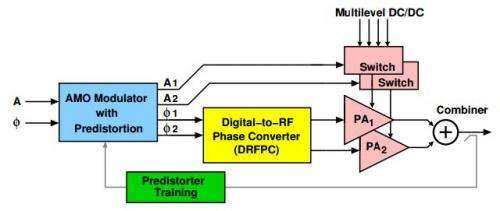November 1, 2012 weblog
Ex-MIT company rethinks power-feasting amplifiers

(Phys.org)—Technologists generally agree that power amplifiers have proven to be inefficient pieces of hardware. Turning electricity into radio signals, they eat into the battery life of smartphones and they waste power. One may find that a cellular phone cannot stream live video without running down the battery in minutes. Now a team of engineers have come up with an alternative amplifier technology that can extend smartphone battery life. Eta Devices, based in Cambridge, Massachusetts with an office in Stockholm, and cofounded by two MIT electrical engineering professors, Joel Dawson and David Perreault, offers a new amplifier design. The result is described in Technology Review as a "blazingly fast electronic gearbox." The engineers call their approach "asymmetric multilevel outphasing (AMO)." It is able to "intelligently" select, among voltages that can be sent across the transistor, the one that minimizes power consumption.
In 2009, Dawson and Perreault, along with SungWon Chung, Philip Godoy, Taylor Barton, and Everest Huang, wrote a paper to describe AMO, calling it a new outphasing transmitter architecture in which "the supply voltage for each power amplifier can switch among multiple levels." They said the AMO modulation technique was found to increase overall efficiency over a much wider output power range than the standard LINC system while maintaining high linearity. "This architecture results in significant efficiency improvement over previous methods."
Dawson, quoted in Technology Review, said that today's power amplifiers used in both phones and cellular base stations are inefficient, "pulling a lot of energy just to keep the thing on." The more data needed to send, the worse it gets. "With high data rate communication, you wind up needing far more standby power than signal power. This is why the phone is warm," he said.
Smartphone battery life, however, is not first in line for Eta Devices, which has been working on their concept, reaching various "milestones" along the way of their R&D. The company will attempt to prove itself next year in applications for Long Term Evolution (LTE) base stations. They hope to reduce base station energy usage by impressive amounts. In large base stations, the power amplifier takes as much as 67 percent of the power, with another 11 percent for air-conditioning. The new amplifier would reduce overall power consumption by half, according to Eta Devices CEO, Mattias Astrom.
The company will launch its product in February at Mobile World Congress in Barcelona. Next will come a chip-scale version of the technology, which is still in development, to increase the battery life of smartphones. They hope for a smartphone chip that can lead to a single-power amplifier to handle the different modes and frequencies used by global standards, including CDMA, GSM, and 4G/LTE. Eta Devices has funding from Ray Stata, cofounder of Analog Devices and Stata Venture Partners.
© 2012 Phys.org


















